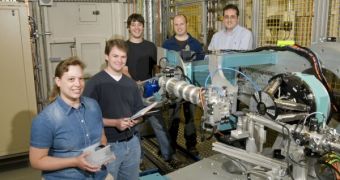On October 12, scientists at the Diamond Light Source, in the United Kingdom, ignited the latest experimental station (I07) at the facility for the first time. The laboratory's purpose is to produce electromagnetic radiation known as synchrotron light, which is generated from charged particles traveling almost at the speed of light. I07, the 14th beamline at the facility, will be used primarily for physics, chemistry and life sciences, PhysOrg reports.
The beamline's X-rays will be able to determine details of individual atoms, and will also help forward a large number of scientific fields, such as, for instance, molecular electronics, or even nanotechnology and bioengineering. One application that springs to mind is the creation of more effective drug-delivery techniques, which still rely on poorly understood nanoparticles at this point. Being able to put together well-understood nanostructures could help scientists create, in the end, transport vessels that deliver their full load on the specified target inside the body.
“We are delighted to welcome first users to I07. Building a new beamline at Diamond has been an exciting challenge and we are pleased to deliver a fantastic scientific tool within budget and beyond specification,” Diamond Surface and Interface diffraction beamline principal beamline scientist Dr. Chris Nicklin explains. The Diamond Light Source was first brought online in 2007. It is located on the site of the Science and Technology Facilities Council Rutherford Appleton Laboratory, near Didcot, in Oxfordshire, the UK.
“This facility will enable scientists to study in detail the structure of an interface in different environments, such as in liquid, gas or vacuum – useful, for example, in understanding and improving real world processes such as catalytic converters or the role of electrodes in fuel cells. We are able to determine the positions of all of the atoms if they form an ordered layer but can also study larger ‘nanostructures’ or clusters of atoms formed at the interface. Now that we have I07 in operation, we will spend the next six to nine months optimizing it to achieve its full potential,” Nicklin further explains.

 14 DAY TRIAL //
14 DAY TRIAL //